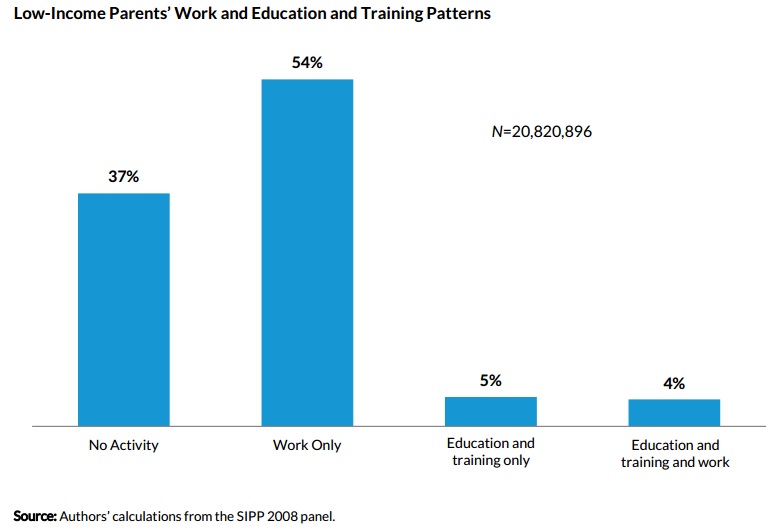
Education and training programs can help low-income parents improve their skills and move up to better-paying jobs, but many families face significant challenges paying for school expenses, juggling work and school, and arranging child care. Knowing more about who these parents are can help shape public policies and programs that support families’ work and education efforts.
Little is known about the prevalence of low-income parents in education and training programs and the barriers they face to participation. In our new brief, we provide a national picture of these parents by analyzing the most recent available data (late 2008 to early 2009) from the Survey of Income and Program Participation. Of the 50 million parents ages 18 to 50 with children under age 12 during this period, nearly 21 million (about 2 in 5) were low-income.
-
About 1.8 million low-income parents (nearly 1 in 10) participated in education and training programs. The vast majority (93 percent) was in postsecondary programs—offered by colleges and universities, as well as private nonprofit and for-profit providers—while the remainder was in adult basic education or GED programs.

- About half of these parents worked while in school. And among these working parents, over half worked full time. This underscores the importance of considering parents’ overall schedule when thinking about their child care needs.
- About one-quarter of low-income parents in education and training had a high school credential but no college education; 11 percent did not have a high school diploma. Anywhere from one- to two-thirds of future jobs may require some education and training beyond high school, so getting additional education and training now could help these parents better support their families.
- Over half of low-income parents in education and training were single mothers. Nearly 70 percent of parents had children age 5 or under; just over half had one child. Child care needs are likely important in shaping their ability to participate.
- Nearly half of low-income parents in education and training are receiving public assistance. Public benefits may be helping low-income parents access these programs as they try to improve their skills and job opportunities.
It is impressive that so many low-income parents are working towards improving their education and skills as they balance their family responsibilities and, often, their jobs. But how can policymakers and practitioners help them succeed? And how can they address low-income parents’ barriers to entry, particularly the lack of reliable child care?
A new project at the Urban Institute—Bridging the Gap: Understanding the Intersection between Workforce Development and Child Care—aims to help answer those questions. Through this project, and with support from the Ford Foundation, we will be looking more closely at workforce development and child care systems and how they do and do not connect in policy and practice. A companion paper, led by my coauthor Gina Adams, highlights the policy connections (and disconnections) between these two systems and how they affect low-income parents. Future research will examine promising strategies and existing challenges to better coordinating workforce development and child care systems, with the ultimate goal of better supporting parents and their career goals.
Tune in and subscribe today.
The Urban Institute podcast, Evidence in Action, inspires changemakers to lead with evidence and act with equity. Cohosted by Urban President Sarah Rosen Wartell and Executive Vice President Kimberlyn Leary, every episode features in-depth discussions with experts and leaders on topics ranging from how to advance equity, to designing innovative solutions that achieve community impact, to what it means to practice evidence-based leadership.